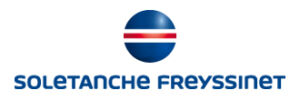Anchored mesh system
Slope retention systems, also known as anchored mesh systems, consist of nets or netting anchored to the slope using a dense matrix of soil or rock anchors and specialized anchor plates. The anchor spacing and placement is determined by the anticipated failure mode and potential mass of material mobilized. The system is designed to resist the loads and retain the material in situ.
The most important material parameters to consider for design are the tensile strength and puncture strength. A common mistake is to specify the tensile strength of an individual wire but this has no relevance to system design.
An integral part of a slope retention system is the method of connection between the mesh and soil/rock anchors. It is imperative that the strength of this connection is known through rigorous testing (puncture strength tests).
Plates used for the connections vary in form and function. In general, they use a combination of corner spikes and welded-on pins to ensure optimum interlocking with the mesh. Some have additional connections for bearing ropes. For those systems using bearing ropes, positive and non- positive couplings are available for both boundary ropes as well as interior ropes. The style used is dependent on the reinforcement requirements and the boundary conditions at the site.
Slope retention systems should be designed on a site-to-site basis since a single approach oversimplifies the design. Depending on the site characteristics and strength requirements, a large variety of net and netting products are available. Additionally, the orientation of the mesh, support cables, and cable connections can be arranged to suite virtually any condition.







